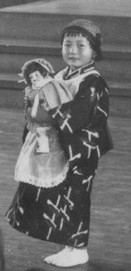|
Main Page
Children's Page |
|
American Blue-eyed Dolls
History Web Sites in Japan Locations Individual Dolls New Dolls |
American
Blue-eyed Dolls
History

|
|
|
|
Japanese stamp issued in 1989 to commemorate the Blue-eyed Dolls |
In 1926, a time of growing tensions between Japan and the U.S., Dr. Sidney L. Gulick came up with the idea to have American children send dolls to the children in Japan. He sought to promote goodwill and peace between the two countries by working through children.
During 1926, the Committee on World Friendship Among Children organized a campaign to gather together dolls and send them to Japan in time to celebrate Hina Matsuri (Doll Festival) on March 3, 1927.
Many American children and adults participated in the doll project, and 12,739 dolls were sent to Japan as little ambassadors of goodwill from the US. Each doll had a name, passport, train and steamship ticket, and letter handwritten by the doll's sender.

|
|
| Girl holds doll from America (1927) |
|
When the American dolls arrived in Japan, they received enthusiastic welcoming ceremonies throughout the country. The dolls were distributed to elementary schools and kindergartens throughout the country. Japanese children loved the dolls very much. They soon became known as "Blue-eyed Dolls" based on a popular children's song entitled "Blue-eyed Doll" by Ujo Noguchi, who wrote many famous children's songs and nursery rhymes.
Despite this great effort to foster peace and understanding between the two countries, war broke out in 1941 between Japan and the US. During World War II, the Japanese government issued an order that the American Blue-eyed Dolls be destroyed since they were considered "enemy dolls." As a result of this order, many dolls were burned, stabbed, or destroyed in other cruel ways. American bombings of Japanese cities in 1945 destroyed other dolls, along with their schools.
Despite the government order to destroy the American dolls, many Japanese school teachers and others hid and preserved the dolls at the risk of being condemned and punished as traitors. About 300 of the American Blue-eyed Dolls have been found. These dolls are treasured by today's Japanese children and adults, since the dolls represent the survival of the ideal of international peace, goodwill, and understanding despite the efforts to suppress it by militaristic propaganda during World War II. The willingness of many brave Japanese teachers and others to risk their lives highlights the significance of Dr. Gulick's idea of the American doll ambassadors sent to Japan in 1927.
1927 photo of welcome to Blue-eyed Doll at Taihei Elementary School, Akita Prefecture